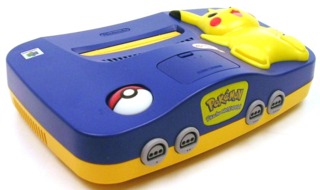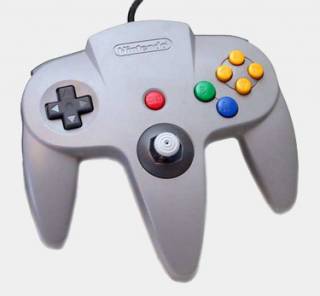Overview
 Pikachu Special Edition N64
Pikachu Special Edition N64The Nintendo 64 (often abbreviated as "N64") is a home game console developed and released by Nintendo in Japan on June 23, 1996, in North America on September 29, 1996, and in Europe and Australia on March 1, 1997. As its name suggests, the console is designed around a 64-bit CPU based on the MIPS processor architecture owned by Silicon Graphics, Inc., marking the first occurrence of a high-performance computing manufacturer like SGI developing technology for a major game console marketed to the general public. The N64's hardware was built to display polygonal 3D graphics natively; this meant a substantial boost in processing power over its predecessor, the Super Nintendo Entertainment System, which required additional co-processors like the Super FX chip for polygons.
Like Nintendo's previous home consoles, the N64 uses cartridges as its software medium. This was in contrast to its two main competitors, the Sony PlayStation and Sega Saturn, both of which used less-expensive compact disc-based media. Although Nintendo 64 games avoided the lengthier load times associated with discs, the decision to use cartridges also meant higher manufacturing costs for game publishers, leading to reduced third-party software support for the N64 over its lifespan.
History
Development
Alhough Nintendo had dominated the Japanese and North American home console markets during the late 1980s with its highly successful Nintendo Entertainment System, serious competition from hardware rivals such as Sega coupled with a national Japanese recession beginning in the early 1990s contributed to comparatively reduced sales figures for Nintendo's 16-bit SNES. With the subsequent rise of polygonal 3D graphics and the appearance of relative industry newcomers such as Sony, Nintendo was in danger of losing a much greater portion of their market share without a proper successor to the SNES.
Silicon Graphics, Inc., a prominent developer of high-performance workstations and graphics applications, had approached Sega in the early 1990s with an offer to develop technology for a powerful next-generation gaming console, but this deal never materialized. After their initial proposal with Sega fell through, SGI successfully approached Nintendo instead, leading to Nintendo and SGI publicly announcing a partnership in August 1993 to co-develop "Project Reality" as Nintendo's next home system. The initial projection was that the as-of-yet-unnamed console would be available in stores "by late 1995...below $250". The culmination of SGI's contribution to this venture was the R4300i microprocessor, a chip developed by SGI's recently acquired subsidiary MIPS Technologies and designed for use in Nintendo's next console. The R4300i was also used in Project Reality software development kits sold as premium-priced "SGI Onyx" systems, which allowed Nintendo's select partner developers to prototype games for their upcoming console before its retail hardware specifications were finalized.
The new system's external design and name were first revealed publicly in a June 1994 press release depicting a curved black console emblazoned with a "Nintendo Ultra 64" logo and featuring a generic ROM cartridge with an identical logo on the front label; however, the system's controller was conspicuously absent. The console's form factor and accompanying cartridges depicted in these early promotional images were essentially identical to the Nintendo 64's final design upon its retail launch in Japan two years later. Around the same time as the "Ultra 64" reveal, Nintendo also signed an agreement with Midway's parent company Williams, allowing Midway to develop and market arcade games based on an arcade-specific variant of the Project Reality hardware. The result of this agreement was two arcade titles, Killer Instinct and Cruis'n USA, both of which reference the "Ultra 64" during their attract modes.
In November 1995, Nintendo unveiled the final version of their upcoming console which was re-branded simply as "Nintendo 64," a new name proposed by Shigesato Itoi. After pushing back the N64's initial "late 1995" launch date by several months to April 1996, the system's Japanese launch was again delayed until June of the same year, with Nintendo stating that the N64's initial software lineup needed more time to mature. However, a former SGI engineer named Adrian Sfarti claimed that hardware issues with the console itself were actually to blame for the delays. Nintendo's marketing team attempted to address the N64's repeated delays with pre-release advertisements featuring slogans such as "Is it worth the wait? Only if you want the best".
Reception & Legacy
The Nintendo 64 was a commercial success but did not not gain popularity as widespread as the Playstation (especially in Japan) nor did it have a vast array of third-party titles. Although it didn't sell as well as Nintendo's earlier machines, it marked a history in video games as it was the console that showed gamers how 2D play styles could be adapted into a 3D world with the analog stick, rumble, and built-in 4 player support. Many of the games on the console (like Super Mario 64, Golden Eye, and The Legend of Zelda: Ocarina of Time) innovated their genre and brought it over to the 3D world.
Thanks to Super Mario 64's 3D gameplay, it started a new trend for free-roaming gameplay and has influenced many series to go in that direction ( Grand Theft Auto, for example). Golden Eye arguably presented the first compelling argument for First Person Shooters on consoles, and was widely lauded for its multiplayer. The Legend of Zelda: Ocarina of Time is considered by many as one of the best games of that generation (getting perfect 10 scores from many reviewers like IGN and Gamespot). Its 3D free-roaming gameplay revolutionized the adventure genre.
The system also introduced several new ideas to the gaming industry. The Nintendo 64 was the first console to introduce a rumble feature to their controller. The Rumble Pak was packaged with Star Fox 64 in 1997. It was a huge leap into getting the player involved in the experience and the feature has been implemented in every controller since then (most notably the DualShock lineup for the Playstation).
It also helped a trend to transfer data from handhelds. Although the Super Game Boy was the first accessory to play Game Boy games on the TV, the Transfer Pak was the first to use data from the games and use them in games. Many games like Pokemon Stadium (in which the Transfer Pak was packaged in with) and Pokemon Stadium 2 used the Pokemon games for the Game Boy to transfer your Pokemon over from the game and use them to fight on their console counterparts (you were also able to play the Pokemon games on your TV). This idea was used for many other systems to come like the Gamecube, Wii, Playstation 2, and Playstation 3.
The Nintendo 64 was succeeded by Nintendo's GameCube in November 2001, but the N64 itself remained in production until its discontinuation in Japan on April 30, 2002, in Australia on May 11, 2003, in Europe on May 16, 2003, and in North America on November 30, 2003.
Accessories
Controller
 The Nintendo 64 Controller
The Nintendo 64 ControllerThe Nintendo 64 featured a unique controller that could be held multiple ways. The three-pronged controller had a center-mounted analog stick, something its competitors Sony and Sega had not implemented yet (though Sega introduced the Sega Saturn's 3-D Controller with an analog stick by the time the N64 hit the market). There was also a traditional directional pad on the left side, and and a set of six face buttons ("A", "B", and the four"C-Buttons") on the right.
The game's center handle also featured a trigger on the back, "The Z Button". This button was used instead of the "L" button in games which used the analog stick.
The underside of the controller featured an expansion slot where various accessories could be inserted to enhance gameplay. This trait was replicated on the controllers for Microsoft's Xbox and Sega's Dreamcast.
Paks
During the lifespan of the N64, Nintendo released various accessory "Paks" used to either enhance the console's existing capabilities or add extra functionality.
 | Controller Pak: A memory card used for save data that is inserted into the underside of the N64 Controller. Many N64 games feature battery backup, which obviates the need for a Controller Pak. However, some third-party N64 titles did not include a battery in order to reduce cartridge manufacturing costs; these games rely on either the Controller Pak or passwords for saving. |
 | Jumper Pak: A placeholder accessory that came pre-installed inside most N64 consoles. Its only purpose is to terminate the N64's RDRAM-based system bus in the absence of an Expansion Pak. |
 | Expansion Pak: An upgrade module that increases the N64's total RAM from 4 MB to 8 MB. N64 games had to be specifically programmed to take advantage of the Expansion Pak's capabilities. This accessory is required to play The Legend of Zelda: Majora's Mask, Donkey Kong 64 and most of Perfect Dark. Certain N64 titles feature optional Expansion Pak support, usually to enable higher video resolutions or a smoother framerate. |
 | Rumble Pak: An accessory inserted into the N64 Controller which provides force feedback while playing certain games. The Rumble Pak was bundled with Star Fox 64 for its initial release and requires two AAA batteries for power. It vibrates in sync with predetermined gameplay scenarios (such as attacking an enemy or taking damage) in order to provide a more immersive experience. Since the Rumble Pak's debut, force feedback has become an industry standard and a "rumble" feature is now built into most modern console controllers. |
 | Transfer Pak: Allows for the transfer of data between the Game Boy and the N64. The Transfer Pak plugs into the N64 Controller, and Game Boy cartridges can be inserted into the top of the Pak. Pokémon Stadium and Pokémon Stadium 2 relied heavily on this accessory in order to transfer individual Pokémon between games for use in battle. |
64DD
 N64 console with 64DD attached
N64 console with 64DD attachedThe Nintendo 64 Disk Drive was an add-on to the N64 console designed to keep third party developers from making games for a CD based system. It allowed the reading of magnetic disks that were larger in capacity to cartridges and allowed for saving data in them.
It was heavily hyped before the system was released. Over time, however, hype for the add-on significantly tapered with consumers expressing concern over having to pay for the system just to play some highly anticipated games. Several games initially planned for the 64DD such as Mario RPG 2 (later renamed Paper Mario) and Zelda Gaiden (later renamed Majora's Mask) were instead released on N64 cartridges as opposed to 64DD disks primarily due to the add on being significantly delay.
The 64DD was eventually released in Japan in December of 1999, with a North American release planned for 2000. However; the idea was ultimately canned. Even in Japan it was only sold through Nintendo's subscription based service RANDnet, and not through ordinary stores. The accessory was a commercial failure and only ten games were ever released:
The rarest of the nine games released on the system is Kyojin no Doshin Kaihou Sensen Chibikko Chikko Daishuugou (Doshin the Giant: Tinkling Toddler Liberation Front! Assemble!) which was last game released after the announcement was made that the Randnet Service would be shutting down and with it the demise of the 64DD.
Other / Third Party
 N64 Glove Controller
N64 Glove Controller- Glove Controller: Nintendo released a controller similar to the Power Glove, however this controller could be used for any game, as it had buttons on the top.
Software
Launch Titles
The Nintendo 64 is notable for featuring the smallest launch software lineup of any Nintendo console.
Best-Selling Games
The following are the top ten best-selling games released for the Nintendo 64.
Log in to comment